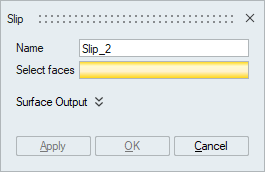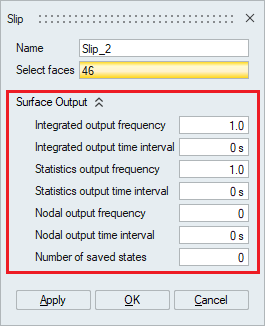Slip
![]()
This panel is used to define the Slip boundary condition for fluid flow problems. Generally, in real physical viscous flows, the fluid at the solid boundary will have zero velocity relative to the boundary or wall. This is called the No-slip condition and due to this a shear stress is developed in the boundary layers.
A Slip boundary condition allows the flow to move along the boundary, that means the velocity at the Slip face is not zero. Slip boundary condition can be applied on faces/face groups of volume meshed bodies.

Description
- Select faces
The faces to which the slip boundary condition needs to be prescribed is selected using Select faces option.
- Surface Output
Surface Output specifies the output parameters for a boundary face.

- Integrated output frequency
Time step frequency at which the integrated surface quantities are output. If zero, this option is ignored.
- Integrated output time interval
Time frequency at which the integrated surface quantities are output. If zero, this option is ignored.
- Statistics output frequency
Time step frequency at which the statistics of surface nodal quantities are output. If zero, this option is ignored.
- Statistics output time interval
Time frequency at which the statistics of surface nodal quantities are output. If zero, this option is ignored.
- Nodal output frequency
Time step frequency at which the surface quantities at the nodes of the surface are output. If zero, this option is ignored.
- Nodal output time interval
Time frequency at which the surface quantities at the nodes of the surface are output. If zero, this option is ignored.
- Number of saved states
Number of solution steps to retain on the disk. If zero, all the solution steps are retained.
- Integrated output frequency